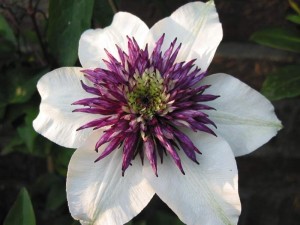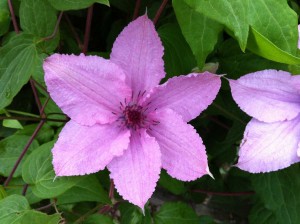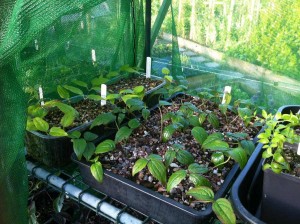Why clematis?

I fell in love with clematis at the age of eight on a holiday in Embleton village, Northumberland, UK. A birthday cake (unfortunately not mine!) impressed itself forever in my memory. A very large, single, purple clematis flower was inserted smack in the middle of its iced top. It was so big it nearly covered the entire surface of the cake. I’d been instructed to find and pluck it from the vicarage garden as a last minute decoration. When the cake was presented for the birthday tea it looked absolutely stunning.
Mrs Carney’s Vicarage Garden
It was that most beautiful and fascinating garden at Embleton Vicarage, maintained and cared for entirely by the vicar’s wife, that inspired me with a lifelong enthusiasm for plants and gardening in general.
The acquisition of my first house in Derbyshire started me down the route of what I call “decorative” gardening, i.e. growing plants that are lovely or interesting to look at. Back home in the North East my father only ever grew fruit and vegetables. He always maintained things weren’t worth growing unless you could eat them – a hangover from the necessities of WW2, and the legacy of pitmen and their allotments – though he still appreciated the beauty of flowering plants.
A few years later my interest in clematis was rekindled. Living and working in Derbyshire for over 20 years, my regular route to the office during the last 10 of those years took me past a cottage garden where a shell-pink clematis grew over a small picket gate. In late summer it was a solid fountain of flowers with never a green leaf to be seen. I used to eagerly look forward to its blooming every year. Later I identified it as “Hagley Hybrid” – a rather unromantic name for such a pretty plant; the Americans more kindly call it “Pink Chiffon”.

Please grow me!
With “Pink Chiffon” waving at me every summer in a taunting manner, the first garden I decided to decorate with clematis was in the town of Wirksworth on the edge of the Peak District. Space is never a problem when it comes to growing clematis. The elevated cottage garden was a mere 15 feet by 30 feet with a path up some steps in the middle leading to the front door. Nevertheless, I managed to squeeze in no less than 45 clematis varieties. They scrambled up the front of the house, around the edges of the garden, and, for good measure, a few more hanging down over the wall into the street below.
My job at that time took me all over the country and I would visit various plant nurseries en route at every opportunity, including the handful of specialist clematis nurseries that still existed back then. Caddick’s clematis nursery in Warrington was always a favourite, as was Beamish Clematis Nursery if venturing to the North East.
How I learned to grow and care for plants
Two years before I moved back to the North East I helped manage an ornamental hardy plant nursery near Matlock. The man who owned it, Hilton Haynes, was a hard-working farmer’s son; a complete task-master and a horticultural perfectionist. These days he grows award-winning acers. During my brief time there I learned an enormous amount about growing and caring for ornamental garden plants in a nursery environment. All plants at his nursery were bought in as “liners” from France or Holland, i.e. small plants ready for potting up and growing on. No plants were propagated from scratch on the nursery itself.
The obsession worsens…
After my return to the north I wandered into Beamish Clematis Nursery looking for a plant or two for my mother’s garden. The nursery was no longer selling just clematis, but a whole variety of ornamental plants. The owner, Colin Brown, remembered my tentative early clematis-buying trips. My visit that day led to me giving a helping hand at Beamish Nursery on an ad hoc basis for the next 13 years until Colin and his partner Jan retired and closed the nursery to the public in 2010.
My own mini nursery
Nowadays the nearest nursery specialising in quality clematis is Taylors in Doncaster, South Yorkshire – a longish trip for just a plant or two!
So, in 2012, armed with a not-anywhere-near-big-enough garden, a 12 x 10 foot greenhouse (courtesy of a family legacy) and half a dozen small electric propagators, I attempted to propagate my own clematis from cuttings. Never having done this before, even during my time at Beamish Nursery, it was definitely trial and error. It’s certainly not an exact science; some varieties take like weeds, others can be a wee bit tricky – evergreens such as clematis armandii are total pigs!

But nothing – for me at least – beats the pleasure derived from starting a plant off as a tiny cutting an inch or two long and watching it romp away a year or two later flowering its socks off.
My own garden collection now stands at 80+ varieties and still expanding. The renowned clematarian, Jim Fisk, christened clematis the Queen of Climbers and I wholeheartedly agree. Whatever the size of your plot, be it only a backyard, balcony, patio or pot, there is always room to squeeze in one of these fabulous hardy plants. No garden can be complete without at least one… or two… or maybe three… or………..
